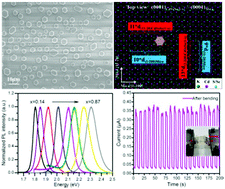van der Waals epitaxial two-dimensional CdSxSe(1−x) semiconductor alloys with tunable-composition and application to flexible optoelectronics†
Abstract
Despite the substantial progress in the development of two-dimensional (2D) materials from conventional layered crystals, it still remains particularly challenging to produce high-quality 2D non-layered semiconductor alloys which may bring in some unique properties and new functions. In this work, the synthesis of well-oriented 2D non-layered CdSxSe(1−x) semiconductor alloy flakes with tunable compositions and optical properties is established. Structural analysis reveals that the 2D non-layered alloys follow an incommensurate van der Waals epitaxial growth pattern. Photoluminescence measurements show that the 2D alloys have composition-dependent direct bandgaps with the emission peak varying from 1.8 eV to 2.3 eV, coinciding well with the density functional theory calculations. Furthermore, photodetectors based on the CdSxSe(1−x) flakes exhibit a high photoresponsivity of 703 A W−1 with an external quantum efficiency of 1.94 × 103 and a response time of 39 ms. Flexible devices fabricated on a thin mica substrate display good mechanical stability upon repeated bending. This work suggests a facile and general method to produce high-quality 2D non-layered semiconductor alloys for next-generation optoelectronic devices.

- This article is part of the themed collection: Editor’s Choice: van der Waals heterostructures


 Please wait while we load your content...
Please wait while we load your content...